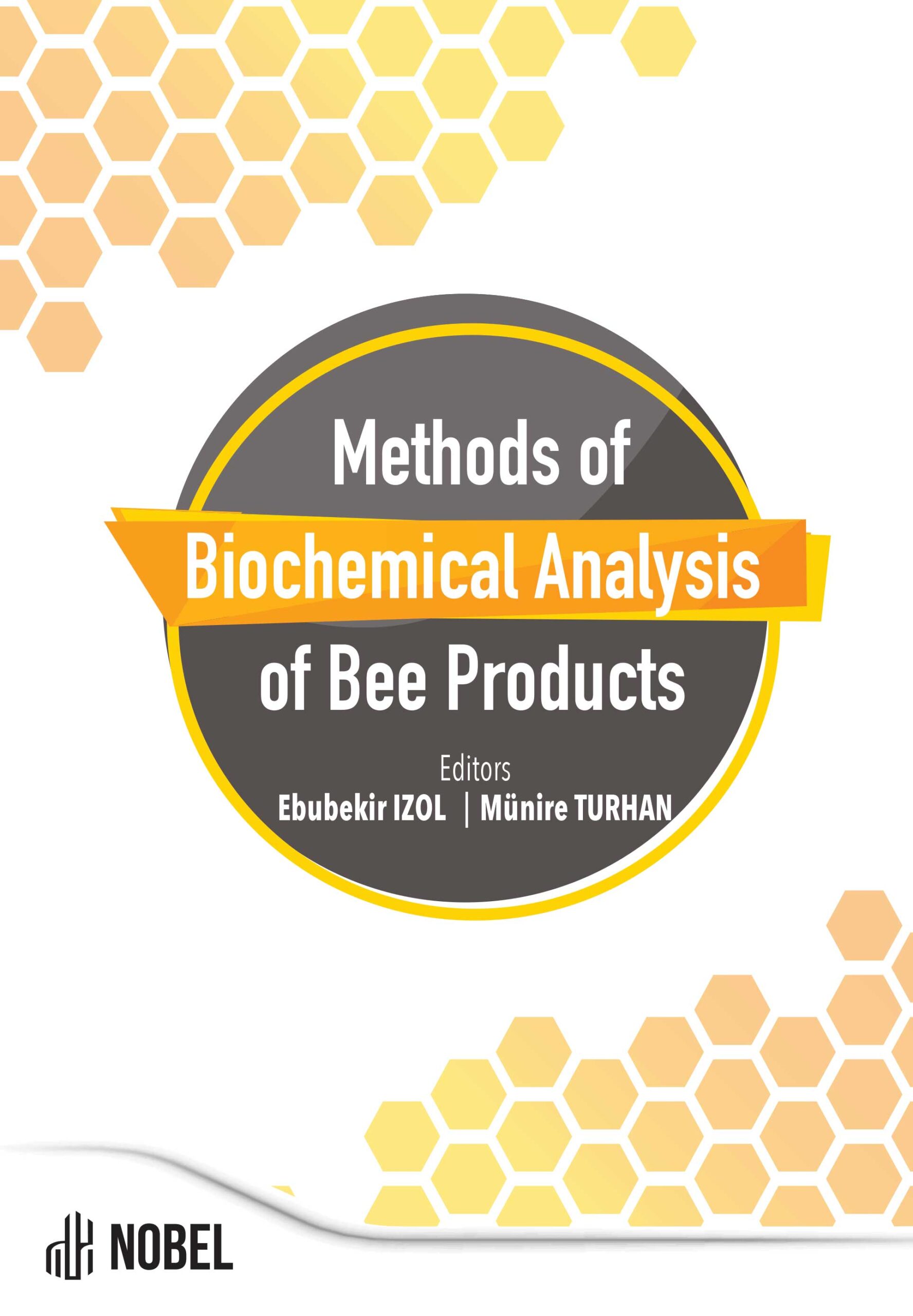Moisture, Electrical Conductivity, Water-Insoluble Solid Matter, Free Acidity and Ph Analysis Methods in Honey
Munire Turhan (Author)
Release Date: 2024-06-07
Honey is a very important natural food consumed as a source of healing. However, it can become harmful due to different chemicals mixed into the content of honey. Naphthalene is a carcinogenic hydrocarbon compound that forms residues in honey. Naphthalene, which beekeepers use to prevent honeycombs from mothballing but are prohibited from using, has many [...]
Media Type
Buy from
Price may vary by retailers
| Work Type | Book Chapter |
|---|---|
| Published in | Methods of Biochemical Analysis of Bee Products |
| First Page | 17 |
| Last Page | 32 |
| DOI | https://doi.org/10.69860/nobel.9786053359326.2 |
| Page Count | 16 |
| Copyright Holder | Nobel Tıp Kitabevleri |
| License | https://nobelpub.com/publish-with-us/copyright-and-licensing |
Munire Turhan (Author)
PhD, Asst. Prof. Dr., Bingöl University
https://orcid.org/0000-0003-3373-1400
3Dr. Münire TURHAN works in the fields of beekeeping, bee breeding, queen bee production, pollination, bee product production and harvesting, bee product preservation methods, bee diseases and pests, and apitherapy. She is an expert in these fields. She has many scientific studies along with field studies in these fields.
İzol, E. (2021). “Yenilikçi Arı Ürünleri ve Biyolojik Önemleri.” In Tarım Uygulamalarında Yenilikçi Yaklaşımlar, ed. İnci H., Kökten K., Iksad Publications, 77–116.
İzol, E., & İzol, İ. 2022. “Arı Ürünlerinin Spektroskopik Yöntemlerle Metal Konsantrasyonlarının Belirlenmesi ve Çevreye Etkileri”, In Tarımsal Üretimde, Tarımsal Kirliliğin Ayak İzi, ed. Kökten K., İnci Ş., Iksad International Publishing House, 1, 209–230.
İzol, E. & Bengü, A.Ş. (2022). “Apiterapi ve Klinik Uygulamalar”, In Sağlık Bilimlerinde İnovatif Yöntemler, Teoriler ve Uygulamalar, ed. Bengü A.Ş., İzol E., Iksad International Publishing House,1, 21
Turhan, M., İzol, E. (2023). “Healing Honey and Harmful Pesticides”, In 2.International Selçuk Scientific Researches Congress Book p:321-328, ISBN: 978-625-367-391-8, October 21-22, Konya, Türkiye.
İzol, E. (2022). “Arı Ürünlerinin Sağlıklı Beslenmedeki Önemi”, In Sağlıklı Yaşam ve Beslenme, ed. Haspolat Y.K., Ertuğrul S., Orient Publications, 313-323.
Yapıcı, İ., İzol, E., Gülçin, İ. (2023). “The Role of Enzymes in Honey Quality”, In Safety of Bee Products, ed. İzol E., Haspolat Y.K., Orient Publications, 1-9.
Anonymous. (2020). Türk Gıda Kodeksi Bal Tebliği. 22 Nisan 2020 tarih ve 31107 sayılı Resmî Gazete, Ankara. https://www.resmigazete.gov.tr/ eskiler/2020/04/20200422-13.htm.
İzol, E. (2023). “The Place of Bee Products in Functional Medicine”, In Functional Medicine Part 2, ed. Haspolat Y.K., Atlı A., Aşır F., Orient Publications, 11-16.
Yapıcı, İ., İzol, E., Tarhan, A. (2023). “Significant Bioactive Components in Bee Products”, In Bee and Bee Products, ed. İzol E., Koçyiğit M., Haspolat Y.K., Orient Publications, 1-15.
FAOSTAT. (2020). Food and Agriculture Organization of the United Nations. https://www.fao.org/faostat/en/#compare
İzol, E. (2023). “Phytochemicals in Honey and Health Effects”, In Honeybees, Plants and Health, ed. Koçyiğit M., İzol E., Haspolat Y.K., Orient Publications, 85-96.
İzol, E. (2023). Bazı Arı Ürünlerinin (Bal, Polen, Propolis, Arı Sütü ve Arı Ekmeği) LC-MS/MS ile Sekonder Metabolitlerinin ve Biyolojik Aktivitelerinin Belirlenmesi. Doktora tezi. Atatürk Üniversitesi Fen Bilimleri Enstitüsü, Erzurum.
Machado De-Melo, A. A., Almeida-Muradian, L. B. de, Sancho, M. T., Pascual-Maté, A. (2018). Composición y propiedades de la miel de Apis mellifera: una revisión. Journal of Apicultural Research, 57(1), 5–37. https://doi.org/10.1080/ 00218839.2017.1338444
Machado De-Melo, A. A., Almeida-Muradian, L. B. de, Sancho, M. T., Pascual-Maté, A. (2018). Composición y propiedades de la miel de Apis mellifera: una revisión. Journal of Apicultural Research, 57(1), 5–37. https://doi.org/10.1080/ 00218839.2017.1338444
Rahman, M. M., Siew, H., Gan, S., Khalil, M. (2014). Neurological Effects of Honey: Current and Future Prospects. Evidence-based Complementary and Alternative Medicine. https://doi.org/10.1155/ 2014/958721
El Sohaimy, S. A., Masry, S. H. D., Shehata, M. G. (2015). Physicochemical characteristics of honey from different origins. Annals of Agricultural Sciences, 60(2), 279–287. https://doi.org /10.1016/j.aoas.2015.10.015
Alqarni, A. S., Owayss, A. A., Mahmoud, A. A., Hannan, M. A. (2014). Mineral content and physical properties of local and imported honeys in Saudi Arabia. Journal of Saudi Chemical Society, 18 (5), 618–625. https://doi.org/https://doi.org/ 10.1016/j.jscs.2012.11.009
da Silva, P. M., Gauche, C., Gonzaga, L. V., Costa, A. C. O., Fett, R. (2016). Honey: Chemical composition, stability and authenticity. Food Chemistry, 196, 309–323. https://doi.org/ 10.1016/j.foodchem.2015.09.051
Sakač, M. B., Jovanov, P. T., Marić, A. Z., Pezo, L. L., Kevrešan, Ž. S., Novaković, A. R., Nedeljković, N. M. (2019). Physicochemical properties and mineral content of honey samples from Vojvodina (Republic of Serbia). Food Chemistry, 276(July 2018), 15–21. https://doi.org/ 10.1016/j.foodchem.2018.09.149
da Silva, P. M., Gauche, C., Gonzaga, L. V., Costa, A. C. O., Fett, R. (2016). Honey: Chemical composition, stability and authenticity. Food Chemistry, 196, 309–323. https://doi.org/ 10.1016/j.foodchem.2015.09.051
De Alda-Garcilope, C., Gallego-Picó, A., BravoYagüe, J. C., Garcinuño-Martínez, R. M., Fernández-Hernando, P. (2012). Characterization of Spanish honeys with protected designation of origin “miel de Granada” according to their mineral content. Food Chemistry, 135(3), 1785– 1788. https://doi.org/10.1016/j.foodchem. 2012.06.057
Anonymous. (2009). Description of methods. Harmonised Methods of the International Honey Comission. https://www.ihc-platform.net/ ihcmethods2009.pdf
| onix_3.0::thoth | Thoth ONIX 3.0 |
|---|---|
| onix_3.0::project_muse | Project MUSE ONIX 3.0 |
| onix_3.0::oapen | OAPEN ONIX 3.0 |
| onix_3.0::jstor | JSTOR ONIX 3.0 |
| onix_3.0::google_books | Google Books ONIX 3.0 |
| onix_3.0::overdrive | OverDrive ONIX 3.0 |
| onix_2.1::ebsco_host | EBSCO Host ONIX 2.1 |
| csv::thoth | Thoth CSV |
| json::thoth | Thoth JSON |
| kbart::oclc | OCLC KBART |
| bibtex::thoth | Thoth BibTeX |
| doideposit::crossref | CrossRef DOI deposit |
| onix_2.1::proquest_ebrary | ProQuest Ebrary ONIX 2.1 |
| marc21record::thoth | Thoth MARC 21 Record |
| marc21markup::thoth | Thoth MARC 21 Markup |
| marc21xml::thoth | Thoth MARC 21 XML |

